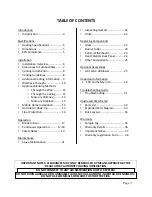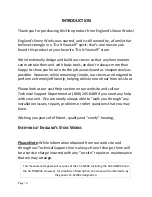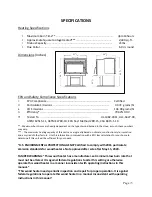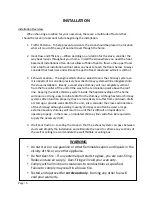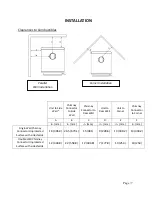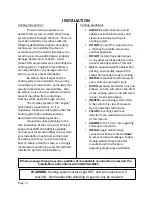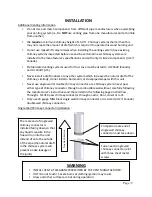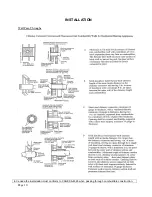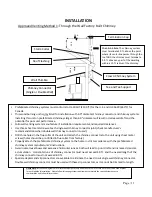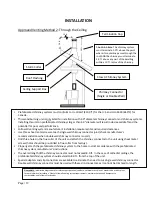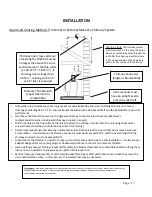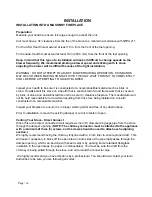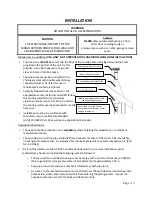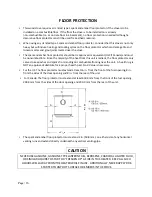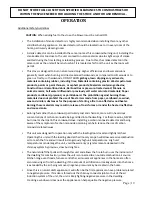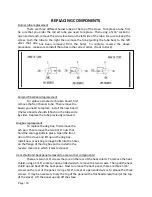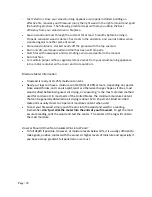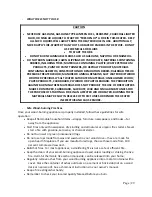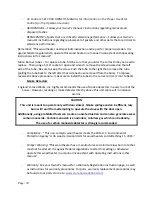
Page | 17
OPERATION
Break
‐
In
Fires
•
This
wood
burning
unit
is
constructed
of
heavy
gauge
steel
and
cast
iron
and
is
built
to
last
a
long
time.
However,
in
order
to
ensure
no
excessive
thermal
stresses
are
induced
on
the
metal
during
the
first
fire,
three
break
‐
in
fires
should
be
burned,
each
one
slightly
hotter
than
the
last.
These
break
‐
in
fires
will
not
only
help
the
stove
body
acclimate
to
the
high
temperatures
of
the
fire,
but
will
also
slowly
cure
the
high
temperature
stove
paint,
which
will
ensure
the
high
quality
finish
lasts
for
years.
•
This
stove
has
a
single
air
control
rod
which
regulates
the
wood
burn
rate;
when
the
primary
air
control
slide
is
pulled
all
the
way
out
of
the
unit,
the
stove
will
burn
more
slowly
and
put
out
heat
over
a
longer
time
period.
Conversely,
when
the
air
control
slide
is
pushed
all
the
way
in,
the
unit
will
burn
more
quickly
and
put
out
a
larger
amount
of
heat
over
a
relatively
shorter
time
period.
Do
not
attempt
to
modify
the
range
of
air
control
adjustment
for
any
reason.
•
The
first
break
‐
in
fire
should
be
just
a
large
kindling
fire,
getting
the
stove
to
about
300
°
F
as
measured
by
a
magnetic
thermometer
on
the
right
or
left
side
of
the
stove,
above
the
door.
Once
this
temperature
has
been
reached,
allow
the
fire
to
die
out
with
the
air
control
open.
The
second
and
third
break
‐
in
fires
should
be
a
bit
larger,
with
some
small
dry
splits
added
to
the
kindling
load.
The
temperature
goal
during
these
fires
is
about
350
°
F
–
450
°
F;
don’t
let
the
fire
get
hotter
than
that.
Continuous
Operation
•
After
the
break
‐
in
fires
are
complete,
this
unit
is
ready
for
continuous
operation.
When
burning
the
stove
continuously,
do
not
allow
ash
and
coals
to
accumulate
higher
than
the
air
hole
in
the
dog
box.
Excessive
coaling
is
often
a
result
of
burning
wood
at
too
high
a
burn
rate,
and
the
coal
bed
should
be
allowed
to
burn
down
before
reloading
the
stove
with
fresh
wood.
•
Combustion
air
is
delivered
to
the
stove
at
two
locations:
The
majority
of
the
primary
combustion
air
enters
the
firebox
via
the
air
‐
wash
system
which
keeps
the
glass
clean
and
feeds
the
primary
combustion
flames
on
the
top
surfaces
of
the
wood;
some
primary
combustion
air
is
fed
into
the
coal
bed
via
the
dog
box
hole
in
the
bottom,
front
box
of
the
stove.
(This
air
is
supplied
from
under
the
unit.)
Every
effort
must
be
taken
to
maintain
the
area
in
front
of
this
hole
free
of
ash.
•
When
loading
the
stove
for
a
long
term
burn,
it
is
most
useful
to
rake
a
“v”
in
the
center
of
the
coal
bed,
to
allow
the
primary
air
bleed
hole
to
push
air
all
the
way
to
the
rear
of
the
unit.
•
After
loading
the
stove
with
a
full
firebox
of
fresh
wood,
it
is
important
to
operate
the
unit
with
the
air
control
in
the
full
open
position
to
properly
char
the
wood
load
and
drive
off
the
initial
moisture
in
the
fresh
wood.
Once
the
wood
has
been
properly
charred
and
is
completely
ignited,
the
air
control
can
then
be
set
to
the
desired
heat
output
level.
o
Air
Control
range:
If
the
air
control
is
pulled
fully
out,
the
stove
is
in
the
Low
Burn
setting.
Pushed
approximately
½
way
in
is
the
Medium
setting,
and
with
the
air
control
pushed
all
the
way
in,
the
stove
is
in
the
High
setting.
•
This
unit
also
offers
a
new
feature.
When
loading
the
stove
for
a
long
low
burn,
you
can
set
the
air
control
damper
to
allow
the
unit
to
heat
up
and
get
a
good
burn
going
before
the
air
is
closed
off
to
the
Low
position.
Simply
pull
the
rod
out
to
Low
and
turn
it
counter
‐
clockwise
until
you
hear
a
slight
“click”
(about
a
quarter
of
a
turn).
When
it
is
ready
the
damper
will
shut
itself.
This
will
work
for
low
and
medium
low
settings.
This
ensures
good
combustion
at
the
Lowest
burn
rate
(or
even
the
Medium
burn
rate,
if
set
to
Medium).

